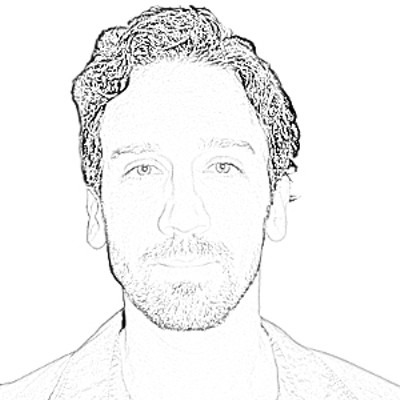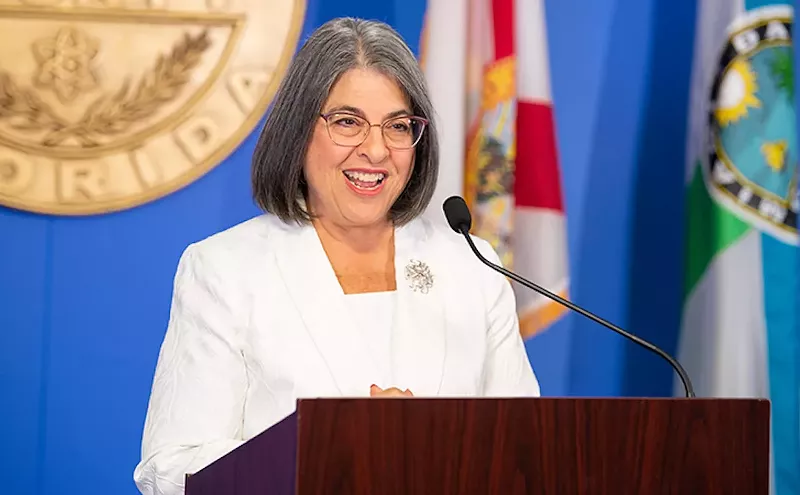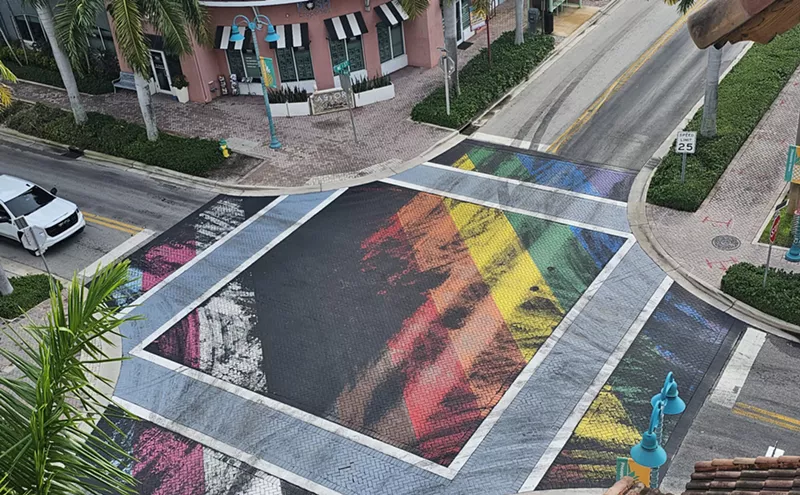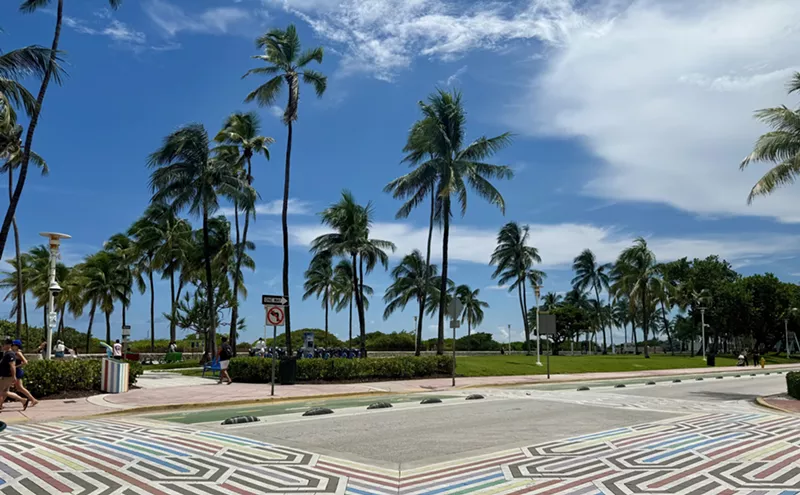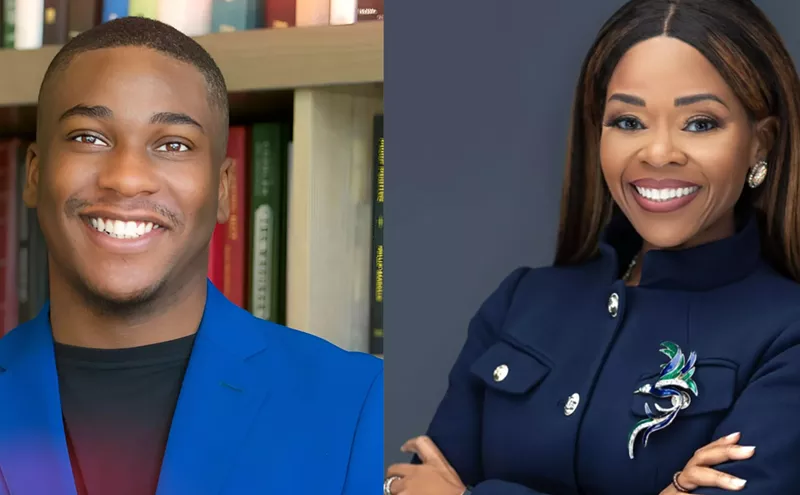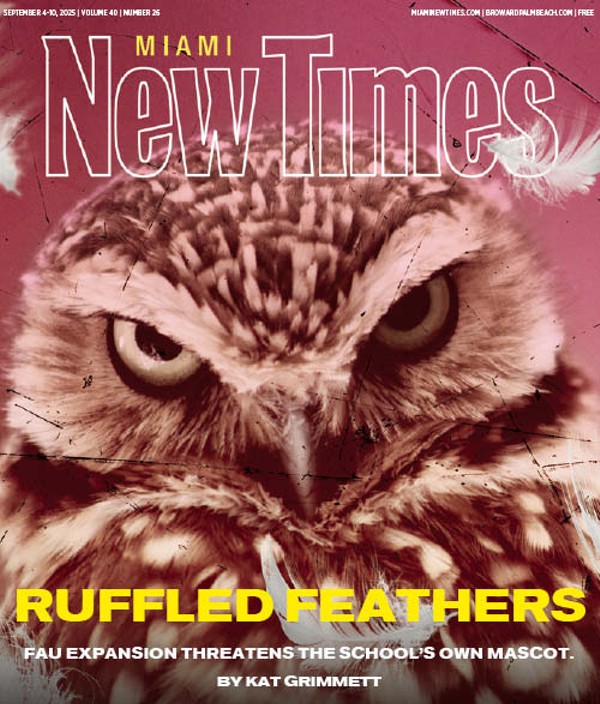Just a few paces from busy Brickell Avenue, Ishmael Bermudez crouches behind his little clapboard house and drinks serenely from a hose lowered into the ancient bedrock. Skyscrapers drape his property in shadows. Across the street, a Metrorail train clamors to a stop at an elevated station. All around, construction cranes pirouette in the sky over the latest wave of megadevelopment.
At 65 years old, Ishmael is a sprightly, spirited man with a long black braid and a gift for understatement. Some people call him by his Native American name, Golden Eagle. Most people just call him Ishmael. Perpetually draped in dusty work clothes, he cuts a slight figure and speaks with a sing-song lilt. He's an amateur archaeologist, a preservationist, and among the longest-standing residents in this neighborhood of newcomers and runaway construction.
Now, as a new wave of foreign cash-fueled property speculation cranks land values back into the stratosphere, he's also turned into a real estate developer's worst nightmare.
"The developers don't have enough money to buy this place," he says, wiping his mouth on his sleeve and raising his voice to be heard over nearby construction and city traffic. He gestures with a sweep of his hand across the yard. "This is one of the most interesting formations in the world. You're never going to see one like this again."
On his property sits a wooden, stone-chimneyed house built in the late 1800s by Bahamian laborers around the time of Miami's founding. A small rear addition was built in 1920. Bougainvillea, pines, and mango trees dot the perimeter, attracting flocks of chattering birds that make the property feel like an oasis. Yet the ground below is a barren moonscape of dark, prehistoric rock.
That's because 50 years ago, Ishmael began painstakingly removing all traces of soil, sand, and sediment from the ground — first with a shovel, then a spoon, then a brush. His efforts fully exposed all 5,000 square feet of the property's bedrock. And in those ancient pits, embedded in the rock itself, Ishmael claims to have found wonders: arrowheads, animal teeth, small artistic curios, empty clamshell piles, a long-fanged feline skull, a gold nugget.
The site's showpiece, though, is a freshwater spring Ishmael contends was used by Miami's vanished early inhabitants, the Tequesta Indians. Next to it, there's a shallow, manmade square cut into the limestone where Ishmael has found animal and human bones. He believes it must have been a ceremonial altar — perhaps even "the oldest altar in this part of the world," he says.
"There's a natural spring there, no doubt about it," says Jeff Ransom, Miami-Dade County's staff archaeologist. "But to say [there's] a Tequesta altar is kind of a stretch."
tweet this
Last year, archaeologists made one of the discoveries of the century just a few miles from Ishmael's home: intact remains of a Native American village from around 500 A.D. Combined with the Miami Circle — a 2,000-year-old site discovered nearby in the late '90s — downtown Miami has become an unlikely hotbed for serious archaeology.
Ishmael believes his backyard belongs in the same breath as those finds. But professional archaeologists aren't so sure. "There's a natural spring there, no doubt about it," says Jeff Ransom, Miami-Dade County's staff archaeologist. "But to say [there's] a Tequesta altar is kind of a stretch."
Ishmael dismisses such snubs. And local Native American leaders say that his amateur archaeology illustrates an important larger truth. The Miami area was a Native settlement for millennia, and much of the city is still sacred ground. Anyone trying to preserve that history should be supported, they say — especially when that ground's real estate value keeps climbing.
With a nearby parcel recently selling for millions and Ishmael's own property value more than tripling in the past two years to more than $1.8 million — not to mention the billion-dollar-plus Brickell City Center project rising just two blocks away — it's no surprise developers have been knocking on his door. But he says that unless his backyard finds are protected, he'll never sell.
"No matter how much they offer me," Ishmael says, "I won't sell. The only time I'll work with developers is when they come to me with a preservation plan where this site is part of whatever they're going to build."
The old, gold-toothed Comanche Indian woman peeked over Ishmael's fence and grinned. Her false teeth beamed under the summer sun. She was thin, with high cheekbones, and despite her 90-plus years, she still had long raven hair. She beckoned the 12-year-old Ishmael to the fence, then said: "Look under the house. Look for a cypress stump."
"Find the tree," Queenie told Ishmael, "and you'll find the water."
tweet this
Her name was Queenie, and she lived in a nearby elderly care home. She'd heard about the 12-year-old Native kid who was turning up arrowheads and strange artifacts in his backyard. She came because her own parents had been forced out of Florida in the 1800s and resettled in Oklahoma, where she heard tales about an ancient spring back in South Florida. According to legend, it was marked by a tall cypress tree.
"Find the tree," Queenie told Ishmael, "and you'll find the water."
That fateful encounter, which came in 1962, would define Ishmael's life for decades to come and — in his telling — lead to a fateful discovery.
When Ishmael first arrived with his family from Colombia five years earlier, the denuded Brickell of today, with its glimmering towers and overflowing traffic, was unimaginable. Back then, the neighborhood was green and made up of pre-war bungalows and colorful, Mediterranean-style apartment buildings. Peacocks called to one another from the rooftops. Stately oaks and wild fruit trees grew in empty lots.
But the neighborhood didn't welcome the Bermudez family with open arms. The area was mostly middle-class white, while Ishmael's father was descended from Navajos and Pueblos and his mother was mestizo. With their tawny complexions, sketchy English, and the era's mounting ethnic tensions, the family was something of an outlier.
Still, Ishmael made friends and found a boyhood paradise in America. After school at Brickell's Southside Elementary, he and his buddies would carry their little sailboats to Biscayne Bay. They'd sail south to Vizcaya, sneak into the Venetian-style mansion, splash in the travertine fountains, and pluck lobsters from the shallow water along the seawall. Then they'd sail to one of the bay's tiny picnic islands and cook their catch on an open fire under the stars.
During shrimping season, Ishmael would tag along with shrimpers many nights and stumble home in the wee hours with buckets of fresh shrimp for his mother to cook. When he got bored with lobsters and shrimp, he'd head west to hang out or play soccer with Seminole Indians in the Everglades.
A few years later, Ishmael's parents decided to buy a house. Ethnic segregation was still common in Brickell, but a group of society ladies helped persuade a local bank manager to approve the Bermudezes' loan. The eight-member family — Mom, Dad, three boys, and three girls — moved out of a rental and into the home that Ishmael and his family would share for the next five decades near the corner of SW 11th Street and 1st Avenue.
Those well-intentioned women started Ishmael on his five-decade backyard odyssey. In 1962, the Soviet Union installed nuclear weapons outside Havana, prompting the Cuban missile crisis. Worried by the prospect, one of those women tasked Ishmael with finding a natural spring. Groundwater, she surmised, wouldn't be immediately affected by nuclear fallout if Miami were attacked.
Young Ishmael soon began digging up his backyard, searching in earnest for fresh water in the middle of Brickell. His mother thought he'd gone crazy. His two brothers resented not being able to play soccer there anymore. His father was just glad his son had a hobby and wasn't roaming the streets.
Just below the topsoil, young Ishmael made his first finds: artifacts and mysterious holes carved into the bedrock. When Queenie showed up one day with her tale of an ancient spring marked by a tall tree, he was inspired to keep looking.
So Ishmael squeezed into the crawlspace under his house with a flashlight and, to his astonishment, found himself staring at an old cypress stump, brittle and ax-scarred. The older half of the house, from the 1800s, had been built right over it.
Queenie became a regular at Ishmael's house after that. She would sit on the ground and chant in her native tongue as young Ishmael dug. Sometimes, she would dance around on the freshly uncovered limestone, her gold teeth shining as she sang, spurring him on to find the spring she was sure was nearby.
By the time he reached his late teens, he had managed to remove almost all of the property's soil to a landfill or piled it up along the perimeter in long levees. Yet, the legendary watering hole was still nowhere to be found.
Then one day in 1969, 19-year-old Ishmael was sitting on his back step during a summer storm, watching the rain fall on the martian landscape he'd excavated.
Suddenly, he noticed something odd about the stump of a large mango tree he and his father had cut down near an exposed pit he'd dug out. The rainwater, Ishmael saw, wasn't pooling in the deep pit but, rather, swirling around it and disappearing.
He grabbed a crowbar, went out in the rain, and pried the stump loose. When it finally budged, he lifted it up and saw a dead taproot disappearing into a hole. He yanked it out. All at once, cool, fresh water came rushing up from underground.
He had found his spring.
In that moment, everything made sense: a small, bone-filled square cut into the rock must have been an altar. The round holes near it were postholes that once supported a structure, like a chickee, over the altar and spring. A large cylindrical rock he found nearby had always mystified him. Now, he could see, the tapered end fit perfectly into the spring's opening. It was, he concluded, a "cork" carved specifically for that purpose.
Queenie, nearing 100 years old now, was overjoyed. She danced, held a special ceremony, showered Ishmael with blessings, and speculated on the spring's history. Before Natives fled to escape Spanish settlers, she theorized, they cut down the tall cypress tree to erase the spring's location marker. Then they laid aside the cork and planted a mango tree on top of the spring to hide the freshwater source.
Shortly after Ishmael found the spring, Queenie disappeared. The elderly home closed down, and the residents had to find new places to stay. Ishmael went looking for her, but no one knew where she'd gone.
"It's strange," Ishmael says. "She didn't say goodbye. Just vanished."
Ishmael came and went from Brickell in the years after finding his spring. He was a hippie for a while, got a pilot's license, and worked as a ship joiner on cruise ships. During those seafaring years, he disembarked in whatever foreign port he found himself and sought out archaeological sites and indigenous people, hoping to gain insight into his find back in Miami.
He says he visited the Natives of Alaska, the Scandinavian tundra, the Mediterranean coast, and the pre-Columbian sites of the Caribbean. Sometimes, he scoured the countrysides looking for rock and fossil formations similar to what he had at home.
In the early 1970s, he traveled to Colombia to investigate his heritage. Shortly after arriving, though, he says the revolutionary guerrilla group FARC kidnapped him from a relative's farm, took him to a remote "hell place" in the mountains, and forced him to work manual labor for a year. He claims he escaped one night while they were drunk.
After that escape, he returned to Miami, worked in construction, got married, had three kids, got divorced, and kept digging. Using the skills he learned as a ship joiner, he decided to jack up his house the same way they jack up ships in dry dock. One wooden shim at a time, he raised his entire house an additional two feet off the ground and spent the next 13 years under the floorboards, excavating by lamplight.
He mostly kept quiet about his site because he wasn't sure if anyone outside the Native community would believe his tale. Still, it was hard to conceal such extensive excavations.
Parolees came to be spiritually cleansed. Sometimes, people tossed dead cats and rabbits over the fence. Someone once left a skinned goat in the alley behind the site.
tweet this
In 1980, during the Mariel boatlift, thousands of Cuban refugees arrived and temporarily lived in a "tent city" under an Interstate 95 overpass, just three blocks west of Ishmael's house. Word of the nearby spring reached the encampment. Refugees walked over at night, and Ishmael filled their buckets with water for drinking and bathing. Eventually, some of those same people started arriving with sick babies and ailing relatives, seeking to be cured by the "indio" and his sacred water.
The Marielitos weren't the only ones to venerate Ishmael's spring. A group of Haitians dropped off a set of wooden figurines to help protect Miami from storms. A man with knee trouble came looking for relief so he could pass the police academy's physical ability test. Parolees came to be spiritually cleansed. Sometimes, people tossed dead cats and rabbits over the fence. Someone once left a skinned goat in the alley behind the site. "Santeria," Ishmael explains.
People left other offerings too: money, skulls, diamonds, rubies, gold. A Native American named Condor dropped off a large crystal after it spent several years being carried around the world to various sacred sites, absorbing energy.
But what had Ishmael really found? In 1999, a startling find turned the world's attention to Brickell — and changed Ishmael's own thinking about the significance of his backyard.
Early that year, a developer had paid $8.5 million for a decrepit Brickell apartment building and then torn it down to build a luxury high-rise. First, though, he had to allow city archaeologists to search the area. They found eye-opening evidence of ancient civilization: the Miami Circle, a roughly 2,000-year-old formation of holes cut into the bedrock near the mouth of the Miami River. The holes, which archaeologists now believe supported a Tequesta ceremonial structure, were the first discovery of their kind. And they lay just six blocks north of Ishmael's home.
In the weeks after the discovery, his home became a meeting point for tribal representatives from around the country who descended on Miami to rally for the circle's preservation. Ishmael let many of them stay with him. Together, they rallied every day at the site to save the circle. Ultimately, they succeeded, and the site is now preserved as a National Historic Landmark.
Ishmael met his current wife, Burke Keogh, at the demonstrations. Impressed with his enthusiasm for saving the circle, she accepted his invitation to see his own piece of Miami history. He showed her the spring and the altar, then convinced her to crawl under the house to see the cypress stump.
Down there, in the dusty darkness of the crawlspace, she decided he was the man for her. She told Ishmael her own story. She grew up in a Caucasian family in upstate New York, within earshot of Niagara Falls. Her grandfather and mother were environmentalists. In the 1970s, Miami lured her in with its aquatic charms.
"When I met Ishmael," she says, "I thought it would take two or three years of telling people about the site and there would be wild excitement that this is something new on the planet that we can study and learn from. But a lot of people say, 'Why isn't National Geographic here? Where's the Discovery Channel? If this is really what you say, why don't I know about it already?'?"
She believes the key to authenticating the site lies with the stone cork. She says she wants to get it carbon-dated. "We have three questions: What's it made of? How old is it? And is there another one like it in the world? But we don't have a lot of money to throw around, and it seems like nobody wants to get involved."
Ishmael shrugs at that suggestion. "Yeah, but that's just for the white world. I already know what's in here."
Archaeologist Jeff Ransom was amid the horde of specialists excavating the Miami Circle back in 1999 when Ishmael approached him with his tale. He also told him about the manmade holes carved into the ground on his property that were strikingly similar to the ones Ransom himself was in the process of uncovering.
Ransom, a Venezuela native who today is Miami-Dade County's staff archaeologist, agreed to take a look. Sixteen years later, he still remembers what he saw. Or, rather, what he didn't see. There's no question that Ishmael had uncovered a natural freshwater spring in the middle of Brickell — but the archaeologist saw little to support his claims that artifacts nearby proved it was a Tequesta holy site.
"A natural spring," Ransom says, "is not uncommon really. You can find those in many places around downtown Miami and Brickell."
Ishmael's home, he explains, is located within a City of Miami Archaeological Conservation area, which means there's a high probability it could have been part of a Tequesta site. But Ransom is skeptical of Ishmael's theories about a square altar cut into the bedrock nearby.
"Historically," he says, "there were a lot of things going on in that area. People were putting up fences, utility poles, things like that. So we find square holes in the rock all over downtown Miami."
One clue Ransom looks for is duricrust, a geological formation that grows on limestone at a measurable rate of around 1 millimeter per thousand years. If a stone cutting is old, it'll have plenty of the formation. "I remember seeing that cut" in the stone at Ishmael's house, Ransom says, "and it didn't have duricrust on it."
Ransom doesn't recall seeing the round holes near the altar either. "But limestone is porous," he says, "and round holes do occur naturally in limestone."
As for the stone cork, he says, "I've seen a lot of natural springs that are located in Tequesta sites. I've never seen one that's plugged."
But Ransom concedes that he paid only one brief visit to the site. And other experts are more sympathetic to Ishmael's view of his find.
Bob Carr held Jeff Ransom's job with the county for more than 20 years and played a pivotal role in the discovery of the Miami Circle. Today, he's the founder and executive director of the Archaeological and Historical Conservancy, a nonprofit organization dedicated to the investigation and preservation of archaeological and historical sites across Florida and the Bahamas.
One day in the late 1990s, he happened to be walking by Ishmael's house and saw the excavation work. He stopped in for a chat and has been back several times since — never as a paid consultant, only as a visitor.
"I haven't studied the site closely," he says. "I would just say this: There are definitely manmade cut holes. They are old. How old they are, that would take additional research. I would have to look at the patina on the inside of the holes... I didn't analyze them carefully."
The spring, Carr says, could very well have been used by the Tequesta, although springs, he acknowledges, are common in that area. Ultimately, though, Carr says Ishmael is a positive force in a town that too often paves over its history: "His efforts really are a welcome contribution to preserving the past and creating a sense of Miami's history. It has merit. It has value. Even if the interpretations aren't proven scientifically."
There's one further complication to Ishmael's tale about a Tequesta well and altar. As he's told the tale through the years, it's grown in complexity and reach. Today, he'll tell any visitor who stops by about the Native American remains — as well as what he believes are prehistoric creatures and early human bones embedded in his property's bedrock.
Striding from rock to rock, sidestepping the holes, he matter-of-factly points out his discoveries to visitors. "That rock there, that's a 'dino' head," he says. "You see, this is the forehead. This is an eye. These are the nostrils. Some of these guys were over ten feet. And there are some that look like alien life forms.
"Over here are the humanoids, or whatever you want to call them," he continues, moving closer to the house and pointing to what look like common rocks. "That's a skull. A female. There's a whole bunch lying around. There, there, and there. Dead, dead, dead."
If Ishmael's Native American claims are in dispute, his ideas about fossils are downright dubious. Large numbers of prehistoric animal remains are rarely found concentrated in a small area. The human remains, meanwhile, would have to predate South Florida's earliest recorded human presence by at least 100,000 years. That's when the bedrock was formed. And South Florida was under water during that period.
But Ishmael says his beliefs are a combination of science and Native creationism. He believes that migrants from Asia populated the Americas some 15,000 years ago but also that other people were already here, that the Great Spirit put them here at the beginning of time. Native origin stories also tell of large, strange animals whose fossils have never been found and many cycles of destruction and creation over millions of years.
"The exploitation of Native people, the desecration of our sites, it's a continuous thing. Somebody has to stand up and say, 'Enough already!'"
tweet this
His beliefs create a quandary for some supporters: Should ancient sites be preserved based on scientific evidence alone, or should Native American mythological and religious views about a site's significance be considered too?
Catherine "Hummingbird" Ramirez, who describes herself as a tribal queen of the Carib people and a shaman, believes it comes down to an issue of respect. She says Native culture and views are often trivialized.
"The exploitation of Native people, the desecration of our sites, it's a continuous thing," she says. "Somebody has to stand up and say, 'Enough already!'?"
Even the Miami Circle has failed to earn local respect, she says. "No Trespassing" signs have disappeared, and residents use the circle as a dog run.
"The Miami Circle is sacred, a national historic landmark," she says. "In no other state will you see a sacred site treated like this. What I see in Miami is a lack of respect for American history."
She and other experts fear more of the same could come for Miami's more recent Native American discovery. Last year, archaeologists working on the site of another planned high-rise along the Miami River announced they'd found a full Tequesta village. "It's one of the earliest urban plans in eastern North America," Carr told the Miami Herald at the time. "You can actually see this extraordinary configuration of these buildings and structures."
But a developer plans to build a 34-story hotel and commercial development on the site. The city eventually hashed out a compromise to preserve part of the historic city, displaying it under glass in the new complex, to be called Met Square.
While politicians cheered that fusion of preservation and progress, Ramirez laments that much of the site will still be destroyed. "These sites need to have a voice," she says. "Somebody has to try hard to make people understand that we [Natives] didn't go away, that we still exist."
That's why Ramirez and others are so supportive of Ishmael. Even if his yard doesn't have the pedigree of the Miami Circle, they say, Miami should be going the extra mile to preserve sites with even the possibility of significant Native history.
Melvin John, a member of the Cree Nation of Canada who spends his winters in Miami, says he's visited Ishmael's site several times. "It's a historical site," he says. "How old? I don't know. But it doesn't diminish the fact that it was used prior to us being here, the city being here."
Local filmmaker Dara Friedman documented Ishmael's story in a short film presented during Art Basel last December. She says the most remarkable part of the tale has been Ishmael's dedication.
"He's made a commitment and really stays true to it," she says. "It's noble... Because that's a lot of temptation that I don't know who else could resist."
On a recent Sunday, Ishmael hunches over an open pit in his yard, bucket and brush in hand. His wife is at his side. Skyscrapers hem them in on three sides.
There's nothing left to excavate, but keeping the site free of leaves and sediment is never-ending work. Ishmael also keeps busy with excavations in other parts of town. He recently completed a dig in Coconut Grove on a site he believes may have been a stopover point for Indians following the southern migration of large game.
Now and then, Ishmael holds full-moon and equinox ceremonies at his site. He removes the stone cork from the spring and lets the water flood the backyard, filling the pits with water from the underlying aquifer. There's a lot of drumming and chanting, and a bonfire illuminates the scene. Residents in a nearby condo tower often call the police. But the cops know him. They come over, tell him to keep it down, and sometimes ask for a tour before leaving.
But lately, he's been getting other visitors too. Developers have been knocking on his door with extravagant offers for years. In the past few months, though, their visits have become more frequent.
And no wonder. Last year, the average sale price per square foot of land in Brickell was $461, according to industry specialists. At that rate, Ishmael's 5,000-square-foot property could fetch some $2.3 million. Due to a dwindling supply and high demand, however, he could easily get much more, especially since his property sits directly across the street from Metrorail's Brickell station — a major selling point to transit-minded buyers.
The speculators' offers, he insists, don't impress him. If he sells, he wants to see the site preserved within whatever new development rises on the spot. Until he gets such an agreement, he'll continue to price his property out of buyers' reach.
"They might be millionaires and billionaires," he says, "but when I tell them how much this costs, they freak out. They say everything is by square foot, and I say, 'No, maybe in your world, but not in this world. You're going to buy a prehistoric site, a part of American history, a landmark in Miami... Do you have $150 million for it, sir?'?"
"There's only one of me against a whole bunch of destructive people. They'd sell their mother, they'd sell their father, they'd sell their wife and everything down the river so they can look good."
tweet this
Some developers, he says, have resorted to dirty tricks to get him to move. One, he says, brought over a city building inspector, hoping the house would be declared unsafe; Ishmael says it passed the inspection, and no liens are currently filed against his property.
He says the same developer convinced the City's Solid Waste Department not to pick up his garbage for three months. He also believes nearby developers use their money and influence to discourage media coverage, explaining why his site hasn't gotten the same attention as the Miami Circle or the Miami River discovery.
"There's only one of me against a whole bunch of destructive people," he says. "They're so involved with what they got. They need a lot of money to survive. They'd sell their mother, they'd sell their father, they'd sell their wife and everything down the river so they can look good."
Max Puyanic, an attorney and real estate investor, owns the property next to Ishmael's. He currently leases it to a 7-Eleven convenience store. He says he'd like to purchase Ishmael's land. Without Ishmael's parcel and the one directly behind it, attracting a large-scale developer to the site would be difficult.
"I have an interest in purchasing his property," Puyanic says, "and I'm sure other people do too... But [Ishmael] is seemingly stuck in a belief pattern regarding what the property is all about and what it's valued for. It's more than I can deal with. I'm interested in a more normal approach."
The idea of preserving Ishmael's site within a new development doesn't appeal to him. "I suppose anybody can contract anything, but that would not be an interesting prospect for me... That's not where I'm at. It's a nice location, and I think if he were more rational in his approach, then something could happen. But I can envision many years going by with nothing transpiring."
Until his 92-year-old father, who lives in the house, passes away, Ishmael says he won't even consider selling. Even then, he's in no hurry to leave. Besides, he says, he has a different philosophy of ownership. "For some reason, I was supposed to uncover this so I can teach others about it," he says. "Right now, this place belongs to the world. All I do is take care of it... It's yours. It's ours. I never say it's mine."
Setting aside his bucket and brush, Ishmael sits quietly next to his spring. He carefully plucks a bee off a nearby rock, places it on his fingertip, and lets it sting him. "They're my medicine," he says. "I've been digging a lot and hurting, so I use them. They heal the muscles, the joints. That's a Native American secret for many, many moons."
Surveying his site, he suddenly grows stern. "When it comes to something like this, it's serious. This is a landmark. The roots of Miami, part of an ancient city. My job is to preserve it, to show it to people. You find something as unique as this and they want to destroy it?"
He releases the bee, smiles as he watches it fly away, and says, "I'm not going to let that happen."


